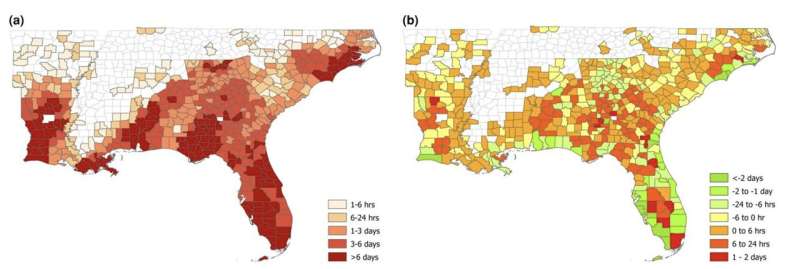Storm tracks and affected counties for the eight hurricanes. Green line: hurricane path. Shaded green: range of sustained wind speeds greater than 34 knots (tropical storm wind level). Blue: Counties with high overall social vulnerability (compared to an average level of 0.726). Red: counties with low overall social vulnerability (compared to the average level). Credit: Georgia Institute of Technology
Hurricanes and other extreme weather events often hit disadvantaged communities hardest, and prolonged power outages are among the most damaging effects. Concerns about intensifying hurricanes have led to new environmental justice policies aimed at mitigating the unequal impacts of major storms. Now policy experts and engineers are focusing their attention on shedding light on the causes.
Researchers at the Georgia Institute of Technology sought to determine whether socioeconomically vulnerable households experienced longer power outage durations after extreme weather events. The team analyzed data from eight major Atlantic hurricanes between 2017 and 2020, which knocked out power to more than 15 million customers in nine states in the southeastern United States. storm – almost three hours longer on average.
The interdisciplinary research team consists of Chuanyi Ji, associate professor in the School of Electrical and Computer Engineering; Scott Ganz, a policy researcher at Georgetown University and former faculty member at Georgia Tech; and Chenghao Duan, a Ph.D. student in Ji’s lab.
Their research article, titled “Socio-economic vulnerability and differential impact of severe weather-induced power outages,” was published in the journal Nexus PNAS.
“Not only do extreme weather events have a more severe impact on disadvantaged communities, but power outages can be dangerous, even deadly, in some contexts,” Ji said. “Those with fewer resources are limited in their ability to evacuate in extreme weather situations, and for people with electrical medical equipment, a prolonged power outage can be disastrous.”
Ji, who specializes in large-scale data analysis for power grid resilience, has previously done work on power restoration procedures involving infrastructure and utilities, but wanted to expand his work to the realm of communities . The team hypothesized that disadvantaged communities would likely wait longer for power to be restored, but to get a realistic picture of the mechanisms at play, the team needed to analyze a wealth of data.
They obtained weather data for eight major hurricanes between 2017 and 2020 from the National Oceanic and Atmospheric Administration as well as additional flood databases. They also looked at power outage data for 15 million customers for the same period, covering nine states, 588 counties and 108 utility regions in the Southeast.
The team used spatial data analysis to model weather impact across regions. They then measured clients’ socioeconomic status using the Social Vulnerability Index, a tool produced by the Centers for Disease Control that takes into account indicators related to poverty, housing costs, education, health insurance and other factors to determine socioeconomic status. Duan and Ji designed the models and estimates, then analyzed the results to reveal the underlying relationship between customers’ socioeconomic status and the duration of their power outage.

Geospatial plot of total observed power outage duration summarized across the eight storms. b) The difference between the total predicted duration of Model 1 and the total predicted duration maintaining socio-economic vulnerability at its average value of 0.718. Credit: Georgia Institute of Technology
Their results show that when comparing rich and poor communities, subject to the same type of impact from weather events, poor communities experienced power outages lasting an average of 170 minutes longer. Specifically, they found that a one-decile drop in socioeconomic status is associated with 6.1% longer outage duration. Their results indicate that there is a statistically significant relationship between socio-economic vulnerability and the time until power is restored.
“Our study also attempts to rule out some possible explanations for why socioeconomically disadvantaged people take longer to restore electricity,” Ganz said. “For example, our study controls for population density in a county and the maximum number of outages in that county, and we still observe that socioeconomically disadvantaged communities experience longer outages.”
He speculated that “the main cause is that poorer communities are also likely to be further from critical infrastructure or need more extensive repairs to power lines, but these are important issues for future research”.
The findings may have important implications for policymakers, highlighting the need to reexamine post-storm recovery and resource allocation policies. Service and utility providers approach electricity harvesting by adhering to policy-driven procedures and regulations. Current research shows that standard procedures for restoring power after large storms, while procedurally fair, can contribute to uneven outcomes. Greater attention to communities could help correct the problem.
“Power grid resilience is not just about infrastructure and utility companies, it is also about the people they serve,” Ji said. “Success in achieving policy goals depends on our ability to identify the characteristics that contribute most to these unequal impacts, which can in turn help us design appropriate interventions to improve outcomes.”
More information:
Scott C Ganz et al, Socio-economic vulnerability and differential impact of severe weather-induced power outages, Nexus PNAS (2023). DOI: 10.1093/pnasnexus/pgad295
Provided by Georgia Institute of Technology
Quote: Research shows disadvantaged people wait much longer for power restored after major storms (December 14, 2023) retrieved December 15, 2023 from
This document is subject to copyright. Apart from fair use for private study or research purposes, no part may be reproduced without written permission. The content is provided for information only.



